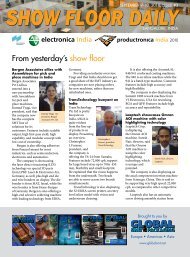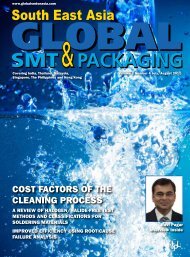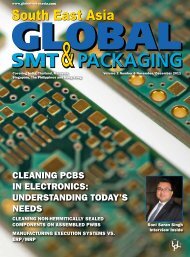South East Asia - WordPress.com - BluOcean.AdMedia
South East Asia - WordPress.com - BluOcean.AdMedia
South East Asia - WordPress.com - BluOcean.AdMedia
You also want an ePaper? Increase the reach of your titles
YUMPU automatically turns print PDFs into web optimized ePapers that Google loves.
Figure 1. Historical and predicted light source efficacies. Figure 2. 2010 version of Haitz’s Law.<br />
new lighting paradigms. Developed by<br />
Kodak 5 in the 1980s, OLED devices were<br />
initially fabricated using vapor deposition<br />
processes. The opportunity to use printing<br />
processes for OLED fabrication opens up<br />
new opportunities.<br />
Presently, OLED efficacy is lower<br />
than that for LED product, but is rapidly<br />
increasing. It is too soon to know whether<br />
OLED products will follow Haitz’s Law.<br />
ssl assembly hierarchies<br />
LED assembly<br />
LED-based SSL assembly follows a 4 level<br />
assembly hierarchy, Table 1.<br />
LED assembly uses a broad range of<br />
SMT processes and unique materials.<br />
Following die singulation and lightemission<br />
testing, binned die (based on<br />
light quality) are assembled into a light<br />
source. A Level 1 LED assembly is depicted<br />
in Figure 3 6 . Ultimately, the light engine is<br />
Figure 3. Level 1 LED package assembly.<br />
www.globalsmtindia.in<br />
placed in a luminaire.<br />
OLED assembly<br />
In contrast to LED assembly, OLED<br />
assembly follows a very different assembly<br />
process, Table 2. While this is still a<br />
four-level assembly hierarchy, Levels 0, 1<br />
and 2 are merged into a <strong>com</strong>prehensive<br />
assembly step since OLED fabrication<br />
intrinsically produces the light source<br />
(Level 0), and light engine (Level 1 and 2)<br />
in an interrelated process, not as a series of<br />
discrete assembly steps, which defines LED<br />
SSL assembly.<br />
This OLED assembly hierarchy<br />
arises from the nature of the OLED<br />
device, which is different from that for a<br />
crystalline based LED. A typical OLED<br />
light source fabricated on a glass substrate,<br />
shown in Figure 4 7 , is <strong>com</strong>posed of a<br />
stack of thin films (usual total thickness<br />
of 100-200 nm) situated between planar<br />
Printed electronics for flexible solid-state lighting<br />
electrodes, with at least one transparent<br />
electrode to enable light to exit the OLED<br />
structure. Descriptions of the various layers<br />
are described in Table 3.<br />
Visible light is created when electrons<br />
and holes, driven by an applied voltage<br />
across the electrodes, <strong>com</strong>bine in the<br />
OLED layers. A luminaire is formed when<br />
the OLED is assembled into a structure<br />
that protects the OLED from physical and<br />
environmental damage as well as supplying<br />
it with electrical energy and control<br />
functions.<br />
SSL OLED technology began as<br />
a display technology. In addition to<br />
developing the materials and fabrication<br />
processes to produce displays, lithography<br />
capable of sub-millimeter resolution was<br />
also required for forming small pixels with<br />
the OLED material sets. While requiring<br />
similar OLED materials and substrates,<br />
SSL requires lower resolution lithography<br />
(i.e., the pixels are larger) so that a critical<br />
display manufacturing step is removed<br />
from the lighting path. The result is a<br />
significant fraction of the manufacturing<br />
cost is reduced for a luminaire relative to<br />
a display, while concurrently increasing<br />
manufacturing throughput and yields.<br />
oleDs for solid-state lighting<br />
As noted in the OLED assembly hierarchy,<br />
Levels 0, 1 and 2 are strongly interrelated.<br />
This interrelation is made more <strong>com</strong>plex<br />
by multiple options available for producing<br />
the OLED device. These include:<br />
• Vapor deposition vs. printed<br />
processes<br />
• Flexible substrate vs. rigid substrate<br />
• Reel-to-reel (R2R) vs. sheet fed<br />
processing<br />
While some OLED material systems can be<br />
Global SMT & Packaging <strong>South</strong>east <strong>Asia</strong> – Winter 2010 – 15









